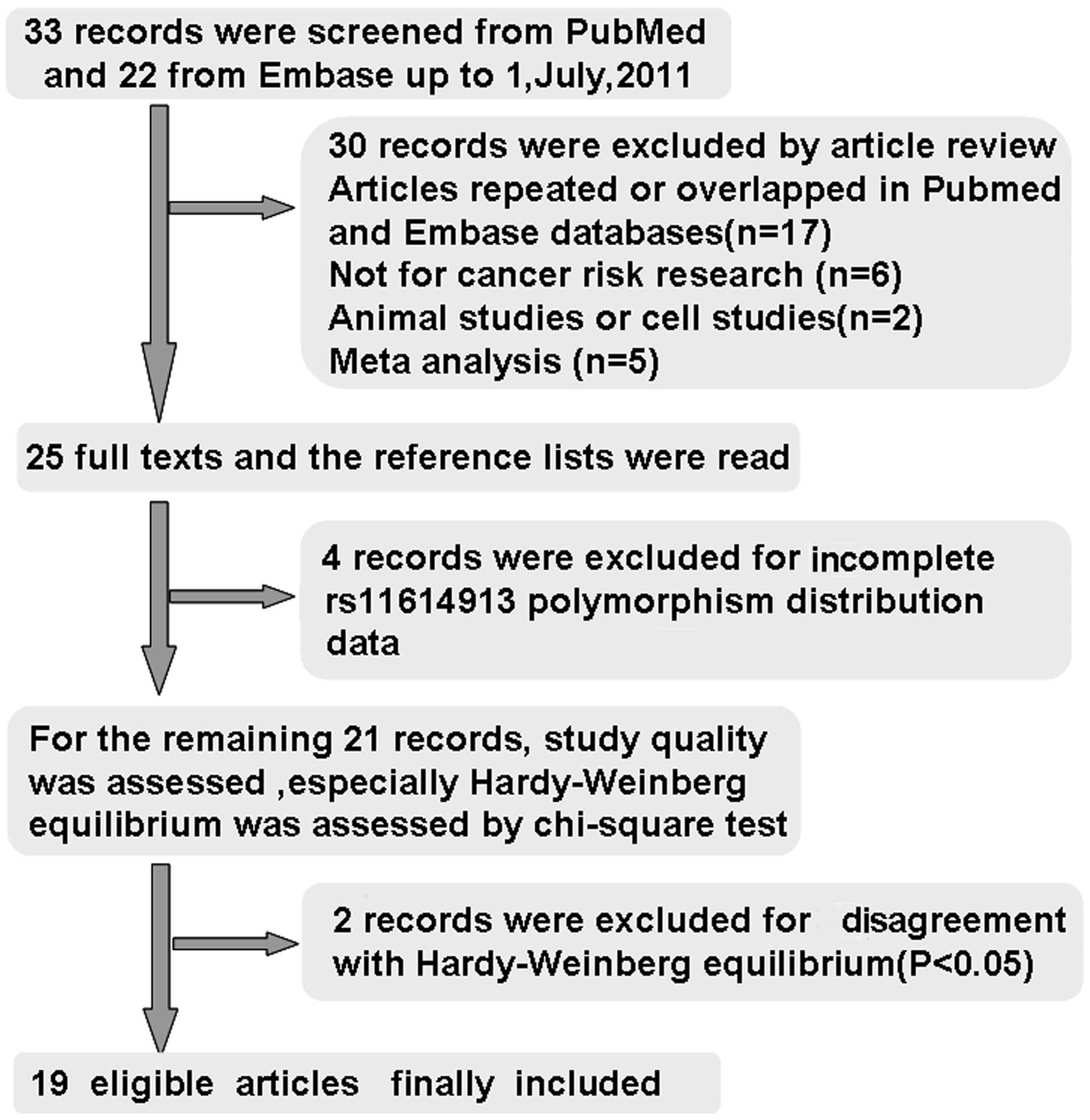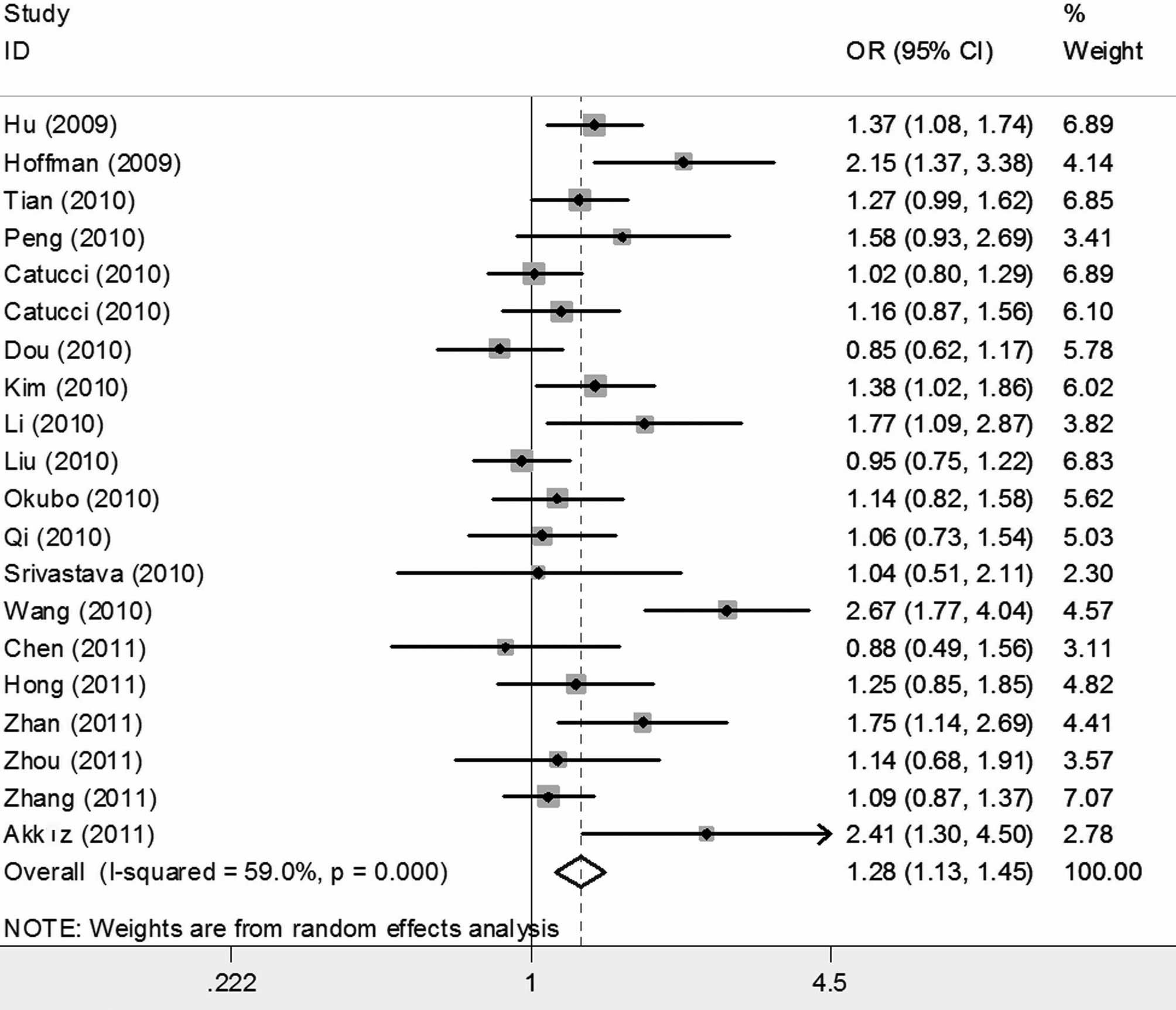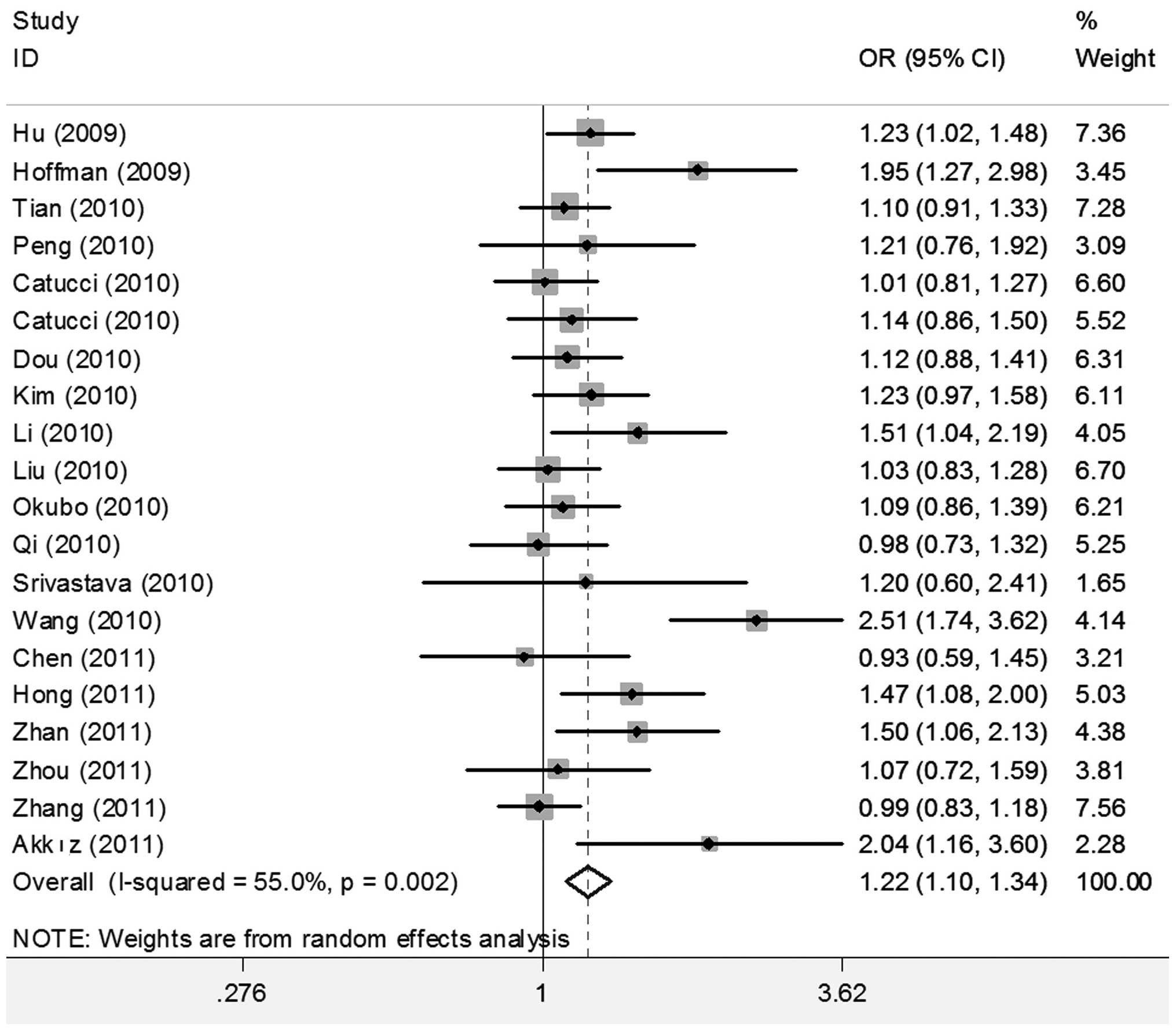miR-196a2 polymorphisms and susceptibility to cancer: A meta-analysis involving 24,697 subjects
- Authors:
- Published online on: December 1, 2011 https://doi.org/10.3892/etm.2011.399
- Pages: 324-330
Abstract
Introduction
During the past several years, extensive effort has been invested in the field of microRNA (miRNA) polymorphisms and the risk of various types of human cancers. miRNAs, originally discovered in Caenorhabditis elegans in 1993 (1) and first reported in 2001 (2), are small, evolutionarily conserved, single-strand non-coding RNA molecules ∼22 nucleotides in length (3,4). It is predicted that miRNAs account for 1–5% of the human genome and regulate at least 30% of protein-coding genes and play a crucial role in cancer (5–7). To date, more than one thousand human miRNAs have been identified. Facilitated by continuing technological advances, to date, most registered miRNAs have been widely studied and the results show that both loss and gain of specific miRNA function contribute to cancer development, shedding more light on cancer prevention, diagnosis, progression and outcome.
hsa-miR-196a2, discovered by Lagos-Quintana et al (8), was initially reported to be a prognostic biomarker for non-small cell lung cancer by Hu et al (9). Since then, emerging molecular epidemiological studies have reported the association between the hsa-miR-196a2 polymorphism and susceptibility to diverse types of human cancer (10–34). Although the precise processes controlling miRNA genetic variants in cancer susceptibility are largely unknown, the importance of miRNA SNPs has been implicated in many cancers. Common single-nucleotide polymorphisms (SNPs), such as hsa-miR-196a2 rs11614913 which is located in the pre-miRNA, may affect the expression and function of mature miRNAs, resulting in diverse functional consequences, thus opening up a new door through which to explore novel molecular mechanisms of cancer development.
These studies have shown that the hsa-miR-196a2 rs11614913 polymorphism occurs in different types of cancer, but the results are generally controversial and inadequate. In addition, the sample size in each study was relatively small, with statistical power too low to detect the association between the hsa-miR-196a2 polymorphism and cancer risk. To solve the problem of inadequate statistical power and controversial results, it is necessary to carry out a systematic review and meta-analysis to improve our current understanding of the association of the hsa-miR-196a2 rs11614913 polymorphism with human cancer risk.
Subjects and methods
Search strategy
The databases, including PubMed and Embase, were searched using: (miR-196a2[All Fields] OR rs11614913[All Fields]) AND (‘neoplasms’[MeSH Terms] OR ‘neoplasms’[All Fields] OR ‘cancer’[All Fields]). The search was restricted to case-control studies published in English and Chinese updated to July 1, 2011. All of the searched studies were reviewed and a manual search of citations from the original studies was performed to identify additional relevant articles.
Inclusion and exclusion criteria
Study quality was assessed according to the proposed checklist of Little et al (35) for reporting and appraising studies of genotype prevalence and gene-disease associations. A study in which all or most of the criteria specified are satisfied would be graded as high quality. The specified inclusion criteria for this meta-analysis were the following: i) case-control studies: cases were patients newly diagnosed and histopathologically confirmed with different types of cancer, while controls were without cancer; ii) evaluation of the association between the rs11614913 and cancer risks; iii) correct statistical analysis and sufficient published data for estimating odds ratio (OR) with 95% confidence interval (CI); and iv) Hardy-Weinberg equilibrium (HWE). Animal studies, pure cell studies, studies not concerned with cancer risk, repeated or overlapping studies, studies without complete rs11614913 polymorphism distribution data and studies not fit for HWE were excluded.
Data extraction
Two investigators independently extracted data using standardized forms. When an agreement was not reached, a third investigator resolved the conflict.
The following characteristics were extracted from each study if available: i) first name of the author; ii) publication year; iii) country or region of origin; iv) ethnicity (different ethnic descents were categorized as Caucasian and Asian); v) genotyping method; vi) source of control (population- or hospital-based controls); vii) cancer type; viii) numbers of cases and controls with miR-196a2 rs11614913 CC, CT and TT genotypes, respectively; and ix) P-value for HWE.
Statistical analysis
Based on the complete hsa-miR-196a2 rs11614913 polymorphism distribution data in cases and controls, the crude ORs with their 95% CIs were performed and displayed as forest plots to assess the strength of association between the hsa-miR-196a2 rs11614913 polymorphism and susceptibility to cancer. The pooled ORs were calculated for homozygote comparison (CC vs. TT), heterozygote comparison (CC vs. CT), dominant model (CC vs. CT/TT) and recessive model (CC/CT vs. TT), respectively. The significance of the pooled OR was determined by the Z-test, and P<0.05 was considered to denote statistical significance. Subgroup analyses were performed for specific cancer types, genotypes, control sources and ethnicities.
Heterogeneity of the study was explored by using both Cochran Q statistic and estimating I2 test (36). When the presence of heterogeneity was detected (P-value <0.10 for the Q-test, I2 values >50%), the random effects model (DerSimonian Laird) was chosen. Otherwise, the fixed effects model (Mantel-Haenszel method) was appropriately used to calculate the pooled OR. HWE in the control group was assessed by the Chi-square test for goodness of fit using a web-based program (http://ihg.gsf.de/cgi-bin/hw/hwa1.pl); P<0.05 was considered significant.
Sensitivity analysis was carried out to assess the stability of the results. A single study involved in the meta-analysis was deleted each time to reflect the influence of the ORs. Publication bias was assessed using Begg and Egger's formal statistical test (statistical significance was defined as P<0.10) (37,38). Statistical analyses were conducted with Stata 10.0 (Stata Corp., College Station, TX, USA), using two-sided P-values. Meta-analysis was performed using the ‘metan’ and ‘metabias’ STATA command.
Results
Characteristics of the included studies
A total of 55 studies were considered to be relevant by literature search from the PubMed and Embase databases (Fig. 1). Thirty studies were excluded by article review, including 17 studies repeated or overlapped in the PubMed and Embase databases; 6 studies were not concerned with cancer risk research, 1 study was an animal study, 1 study was a cell study, and 5 studies were meta-analysis. During the reading of the 25 full-text manuscripts, 4 studies were excluded due to incomplete rs11614913 polymorphism distribution data required for OR calculation (10–13). For the remaining 21 records, baseline characteristics of the patients and control subjects were summarized, the study quality was assessed, HWE in particular was assessed by Chi-square test; two records involving Indian populations published in 2011 were excluded for disagreement with HWE (P<0.05) (14,15), thus leaving 19 articles identified with criteria for inclusion and exclusion (16–34). All studies were case-control studies. The cases were patients with cancer, and the controls were without cancer. The reported age and gender distributions were also recorded. By quality assessment, these studies satisfied most of the criteria specified by Little et al (35). In the study of Catucci et al (20), the genotype frequencies were presented separately for a German and an Italian group, thus each group in the study was considered separately for meta-analysis. Therefore, a total of 20 studies including 11,004 cases and 13,693 controls were included in the meta-analysis.
Table I shows the characteristics of the 20 studies, including first name of the author, year of publication, country of origin, ethnicity, genotyping method, source of controls, cancer type, numbers of cases and controls with miR-196a2 rs11614913 CC, CT and TT genotypes, respectively and P-value for HWE. Among 20 studies, 2 studies were published in 2009, 12 studies were published in 2010, and 6 studies were published in 2011. There were 15 studies of Asians, 4 studies of Caucasians, and 1 study of mixed population with no detailed data on ethnicity. Multiple genotyping methods were employed in the studies included in our analysis: 10 studies using polymerase chain reaction-restriction fragment length polymorphism (PCR-RFLP), 3 studies using TaqMan SNP genotyping assay, 3 studies using polymerase chain reaction-ligation detection reaction (PCR-LDR), others using MassARRAY multiplex, and DNA sequencing. A blood sample was used for genotyping in all the studies. There were 4 breast cancer studies, 4 hepatocellular carcinoma (HCC) studies, 3 lung cancer studies, and other cancer types. The controls of 16 studies mainly came from a hospital-based healthy population (HB) matched for gender and age, and 4 studies had population-based controls (PB). The distribution of genotypes in the controls of all of the studies was in agreement with HWE (P>0.05).
Main meta-analysis results
When all studies were pooled into the meta-analysis, the hsa-miR-196a2 rs11614913 polymorphism was significantly associated with an increased cancer risk in all genetic models (CC vs. TT: OR=1.280; 95% CI 1.131–1.449, P<0.001; CT vs. TT: OR=1.187, 95% CI 1.079–1.306, P<0.001; CC/CT vs. TT: OR=1.216; 95% CI 1.104–1.341, P<0.001; and CC vs. CT/TT: OR=1.115, 95% CI 1.025–1.213, P=0.011) (Figs. 2 and 3).
Next we performed the subgroup analysis of different specific cancer types, genotypes, control sources and ethnicities (Table II). In the different cancer types, individuals carrying the CC genotype had an elevated risk of breast cancer (CC vs. TT: OR=1.305, 95% CI 1.012–1.684, P=0.041; and CC vs. CT/TT: OR=1.114, 95% CI 1.011–1.227, P=0.029), lung cancer (CC vs. TT: OR=1.299, 95% CI 1.096–1.540, P=0.003; and CC vs. CT/TT: OR=1.791, 95% CI 1.022–1.360, P=0.024), digestive system cancer including gastric and CRC (CC vs. TT: OR=1.292, 95% CI 1.041–1.603, P=0.020; and CC vs. CT/TT: OR=1.215, 95% CI 1.015–1.455, P=0.034) and HCC (CC vs. CT/ TT: OR=1.200, 95% CI 1.038–1.387, P=0.014) compared with those with the TT or TC/TT genotypes. In addition, individuals carrying the CT genotype had an elevated risk for breast cancer (CT vs. TT: OR=1.151, 95% CI 1.012–1.310, P=0.032) and other cancers (CT vs. TT: OR=1.352, 95% CI 1.008–1.814, P=0.044) compared with those with the TT genotype. Individuals carrying the CC/ CT genotype had an elevated risk of lung cancer (CC/CT vs. TT: OR=1.206, 95% CI 1.054–1.380, P=0.007) compared with those with the TT genotype.
Table II.Subgroup meta-analysis results of the hsa-miR-196a2 rs11614913 polymorphism and cancer risk. |
In the different genotypes, the hsa-miR-196a2 rs11614913 polymorphism was associated with a significantly increased cancer risk in all genetic models by PCR-RELP (CC vs. TT: OR=1.318, 95% CI 1.127–1.541, P=0.001; CT vs. TT: OR=1.410, 95% CI 1.038–1.252, P=0.006; CC/CT vs. TT: OR=1.181, 95% CI 1.081–1.290, P<0.001; and CC vs. CT/TT: OR=1.170, 95% CI 1.014–1.350, P=0.032), and others (CC vs. TT: OR=1.662, 95% CI 1.113–2.482, P=0.013; CC/CT vs. TT: OR=1.518, 95% CI 1.012–2.278, P=0.044; and CC vs. CT/TT: OR=1.237, 95% CI 1.097–1.395, P=0.001), but no significant associations were observed by PCR-LDR and TaqMan.
In Asian, but not Caucasian ethnicity, significantly increased risks were observed in all genetic models (CC vs. TT: OR=1.283, 95% CI 1.120–1.470, P<0.001; CT vs. TT: OR=1.187, 95% CI 1,058–1.331, P=0.003; CC/CT vs. TT: OR=1.214, 95% CI 1.088–1.354, P=0.001; and CC vs. CT/TT: OR=1.129, 95% CI 1.019–1.251, P=0.021).
Hospital-based studies demonstrated a significantly increased risk in all genetic models (CC vs. TT: OR=1.314, 95% CI 1.117–1.544, P=0.001; CT vs. TT: OR=1.233; 95% CI 1.097–1.386, P<0.001; CC/CT vs. TT: OR=1.361, 95% CI 1.114–1.428, P<0.001; and CC vs. CT/TT: OR=1.115, 95% CI 1.010–1.231, P=0.031). Population-based studies demonstrated significantly increased risks only for the CC genotype when compared with the TT genotype (OR=1.225, 95% CI 1.071–1.401, P=0.003).
Sensitivity analysis and publication bias
The overall results in the random model or fixed model were similar. In addition, sensitivity analysis was also carried out by deleting a single study in the meta-analysis each time. The results showed that no individual study affected the overall OR dominantly (data not shown). There was no evidence for publication bias according to Begg’s (z=1.40, P=0.163) and Egger’s tests (t=1.32, P=0.202) for CC vs. CT/TT.
Discussion
Principal findings
In the present meta-analysis including 11,004 cases and 13,693 controls, we found that the hsa-miR-196a2 rs11614913 polymorphism was associated with significantly increased overall cancer risk in all genetic models. This meta-analysis provides compelling evidence that the hsa-miR-196a2 rs11614913 polymorphism may play a crucial role in the development of cancer and may be used as a candidate biomarker for cancer susceptibility. Moreover, in our subgroup analysis, we indicated that individuals carrying the CC genotype had a significantly elevated risk of breast cancer, lung cancer, digestive system cancer (including gastric and CRC) and HCC compared with those with TT or TC/TT genotypes, consistent with the total results. Ryan et al (39) suggested that variations in miRNAs may be related to the risk of cancer and reported that the rs11614913 polymorphism located in the hsa-miR-196a2 3′ mature sequence affects the maturation and may affect target mRNA. Cell culture experiments also indicated that high hsa-miR-196a levels could suppress the activities of various cancer-related genes, such as ANXA1 (Annexin A1), suppression of which is well documented in various cancer types (40,41). Li et al (23) conducted an analysis of rs11614913 genotypes and the expression of mature miR-196a. They found that the expression level of hsa-miR-196a was significantly higher in CC patients or patients carrying at least one C allele than in TT patients. The CC homozygotes were associated with a statistically significant increase in mature miR-196a. Therefore, the altered expression patterns of miR-196a influence its potential targets and may play a role in the regulatory processes that occur during cancer development.
Over the past several years, a large number of distinct genotyping approaches have been designed for SNP detection and identification, typically involving the amplification of the target DNA sequence and the detection of SNPs, but each genotyping method has its merit and demerit. A proper technology platform should be adopted according to the sample size and the amount of SNPs (42). The results of PCR-RFLP, PCR-LDR, TaqMan and other methods to detect the hsa-miR-196a2 rs11614913 polymorphism may not be in full accord. We found that the hsa-miR-196a2 rs11614913 polymorphism significantly increased cancer risk in all genetic models using the PCR-RFLP method, but not using the PCR-LDR method. Therefore, a great deal of effort should be devoted to developing more accurate, rapid, and cost-effective technologies for SNP analysis.
In the subgroup analysis of source of controls and ethnicities, hospital-based and population-based studies demonstrated significantly increased risks for the CC genotype compared with the TT genotype. A population-based control can better represent the population, but hospital-based controls are more readily obtainable in research. In addition, significantly increased risks were observed in an Asian but not in a Caucasian ethnic population, suggesting potentially different mechanisms in different populations according to different genetic background and environment. More studies in other ethnic groups may be necessary for further progress in this area.
Strengths and limitations of the meta-analysis
Several limitations of this meta-analysis should be mentioned. First, the meta-analysis was limited by a relatively small number of available studies. It is difficult to perform subgroup analysis for every type of cancer. Second, our analysis was limited to Asian and Caucasian ethnicities, so it is uncertain whether these results are generalizable to other populations. Third, restriction to studies published in English or Chinese may confer potential language bias. In addition, studies with no statistically significant results often have less chance for publication. It is still difficult to rule out potential publication bias in the meta-analysis. To confirm the role of the hsa-miR-196a2 rs11614913 polymorphism in cancer risk requires further larger studies in different populations and in different types of cancer.
In spite of these limitations, our meta-analysis had several strengths. In genetic association studies, the sample size and statistical power are often of particular importance. We overcame the limitations of a single study involving a relative small number of subjects and the limitation in the statistical significance, as relatively more sufficient number of cases and controls were pooled from different studies, which significantly increased the statistical power of the analysis. In addition, this meta-analysis not only assessed the total strength of association between the hsa-miR-196a2 rs11614913 polymorphism and overall cancer risk in all genetic models, but also further performed subgroup analysis of different specific cancer types, genotypes and control sources to assess the polymorphism with cancer risk.
In conclusion, this meta-analysis provides compelling evidence that the hsa-miR-196a2 rs11614913 polymorphism may play a crucial role in the development of cancer, and that screening of patients for the hsa-miR-196a2 rs11614913 polymorphism is clinically useful for the prediction and prevention of cancer.
Abbreviations:
|
miRNAs |
microRNAs |
|
SNPs |
single nucleotide polymorphisms |
|
OR |
odds ratio |
|
CI |
confidence interval |
|
HWE |
Hardy-Weinberg equilibrium |
|
PCR-RFLP |
polymerase chain reaction-restriction fragment length polymorphism |
|
PCR-LDR |
polymerase chain reaction-ligation detection reaction |
|
HCC |
hepatocellular carcinoma |
|
HB |
hospital-based healthy controls |
|
PB |
population-based controls |
|
ANXA1 |
Annexin A1 |
Acknowledgements
This study was supported by grants from the NCET-10-0919, National Natural Science Foundation (no. 30801324), the Foundation of Shandong Natural Science (nos. ZR2009CL005 and ZR2009CQ033), and the Scientific Research Foundation of Shandong Educational Committee (nos. J09LF11 and J08LG15).













